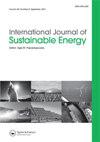加纳绿色氢势评估:PEM电解工艺和地理空间多标准方法的应用
IF 2.7
Q4 ENERGY & FUELS
引用次数: 0
摘要
随着绿色氢作为一种可行的可持续能源选择越来越受欢迎,本研究探索了加纳利用风能和太阳能生产绿色氢的潜力。该研究结合使用地理空间多标准方法和PEM电解过程来估计所选两种可再生资源的地理和技术潜力。该研究还包括对电网整合的潜在领域的评估。应用了单晶太阳能光伏组件和1mw风力涡轮机组件的技术规范。评估结果表明,该国约85%的土地面积可用于绿色氢项目。从技术上讲,该国每年可生产约14,196.21万吨太阳能绿色氢和约10,123.36万吨风能绿色氢。还观察到,一些地区,特别是该国北部地区,尽管显示出太阳能绿色氢项目的最有利位置,技术潜力超过1500万吨/年,但根据该国目前的电气化政策,由于该地区人口密度低,距离电网门槛很远,这些地区可能没有资格获得并网系统。本文章由计算机程序翻译,如有差异,请以英文原文为准。
Green hydrogen potential assessment in Ghana: application of PEM electrolysis process and geospatial-multi-criteria approach
With green hydrogen gaining traction as a viable sustainable energy option, the present study explores the potential of producing green hydrogen from wind and solar energy in Ghana. The study combined the use of geospatial multi-criteria approach and PEM electrolysis process to estimate the geographical and technical potential of the selected two renewable resources. The study also included an assessment of potential areas for grid integration. Technology specifications of a monocrystalline solar PV module and 1 MW wind turbine module were applied. Results of the assessment show that about 85% of the total land area in the country is available for green hydrogen projects. Technically, capacities of ∼14,196.21 Mt of green hydrogen using solar and ∼10,123.36 Mt/year from wind energy can be produced annually in the country. It was also observed that some regions, especially regions in the northern part of the country even though showed the most favourable locations for solar-based green hydrogen projects with technical potential of over 1500 Mt/year, these regions may not qualify for a grid connected system based on the current electrification policy of the country due to the regions’ low population density and distance from the power grid network threshold.
求助全文
通过发布文献求助,成功后即可免费获取论文全文。
去求助
来源期刊

International Journal of Sustainable Energy
ENERGY & FUELS-
CiteScore
5.70
自引率
3.20%
发文量
52
期刊介绍:
Engineering and sustainable development are intrinsically linked. All capital plant and every consumable product depends on an engineering input through design, manufacture and operation, if not for the product itself then for the equipment required to process and transport the raw materials and the final product. Many aspects of sustainable development depend directly on appropriate and timely actions by engineers. Engineering is an extended process of analysis, synthesis, evaluation and execution and, therefore, it is argued that engineers must be involved from the outset of any proposal to develop sustainable solutions. Engineering embraces many disciplines and truly sustainable solutions are usually inter-disciplinary in nature.
 求助内容:
求助内容: 应助结果提醒方式:
应助结果提醒方式:


